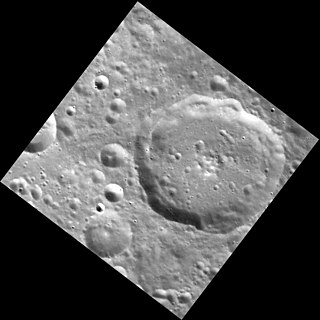
Jan Nepomuk Neruda was a Czech journalist, writer, poet and art critic; one of the most prominent representatives of Czech Realism and a member of the "May School".
Johann Baptist Georg Neruda was a Czech classical composer, violinist and cellist.

The Eminescu quadrangle (H-9) is one of fifteen quadrangles on Mercury. It runs from 216 to 288° longitude and from -25 to 25° latitude. Named after the Eminescu crater, it was mapped in detail for the first time after MESSENGER entered orbit around Mercury in 2011. It had not been mapped prior to that point because it was one of the six quadrangles that was not illuminated when Mariner 10 made its flybys in 1974 and 1975. These six quadrangles continued to be known by their albedo feature names, with this one known as the Solitudo Criophori quadrangle.

The Debussy quadrangle (H-14) is one of fifteen quadrangles on Mercury. It runs from 270 to 360° longitude and from -20 to -70° latitude. Named after the Debussy crater, it was mapped in detail for the first time after MESSENGER entered orbit around Mercury in 2011. It had not been mapped prior to that point because it was one of the six quadrangles that was not illuminated when Mariner 10 made its flybys in 1974 and 1975. These six quadrangles continued to be known by their albedo feature names, with this one known as the Cyllene quadrangle.

The Neruda quadrangle (H-13) is one of fifteen quadrangles on Mercury. It runs from 180 to 270° longitude and -20 to -70° latitude. Named after the Neruda crater, it was mapped in detail for the first time after MESSENGER entered orbit around Mercury in 2011. It had not been mapped prior to that point because it was one of the six quadrangles that was not illuminated when Mariner 10 made its flybys in 1974 and 1975. These six quadrangles continued to be known by their albedo feature names, with this one known as the Solitudo Persephones quadrangle.

Atget crater is distinctive on the planet Mercury's surface due to its dark color. Atget crater is located within Caloris basin, near Apollodorus crater and Pantheon Fossae. The dark color of the floor of Atget is in contrast to other craters within Caloris basin that exhibit bright materials on their floors, such as the craters Kertész and Sander. Other craters on Mercury, such as Bashō and Neruda, have halos of dark material but the dark material does not cover the crater floors.

Burns is a crater on Mercury. It has a diameter of 43 kilometers. Its name was adopted by the International Astronomical Union (IAU) in 1985. Burns is named for the Scottish poet Robert Burns, who lived from 1759 to 1796.

Camões is a crater on Mercury. It has a diameter of 70 kilometers. Its name was adopted by the International Astronomical Union (IAU) in 1976. Camoes is named for the Portuguese poet Luís de Camões, who lived from 1524 to 1580.

Carducci is a crater on Mercury. It has a diameter of 108.19 kilometers. Its name was adopted by the International Astronomical Union (IAU) in 1976. Carducci is named for the Italian poet Giosue Carducci, who lived from 1835 to 1907.

Darío is a crater on Mercury. It has a diameter of 151 kilometers. Its name was adopted by the International Astronomical Union (IAU) in 1976. Dario is named for the Nicaraguan poet Rubén Darío, who lived from 1867 to 1916.

Derzhavin is a crater on Mercury. It has a diameter of 156 kilometers. Its name was adopted by the International Astronomical Union in 1979. Derzhavin is named for the Russian poet Gavril Derzhavin, who lived from 1743 to 1816.

Donne is a crater on Mercury. It has a diameter of 86 kilometers. Its name was adopted by the International Astronomical Union (IAU) in 1976. Donne is named for the English poet John Donne, who lived from 1572 to 1631.

Dvorák is a crater on Mercury. It has a diameter of 75 kilometers. Its name was adopted by the International Astronomical Union (IAU) in 1976. Dvorák is named for the Czech composer Antonín Dvořák, who lived from 1841 to 1904.

Firdousi is a crater on Mercury. It has a diameter of 98 kilometers. Its name was adopted by the International Astronomical Union (IAU) in 2010. Firdousi is named for the Iranian poet Hakim Ferdowsi, who lived from 940 to 1020.

Hitomaro is a crater on Mercury. It has a diameter of 105 kilometers. Its name was adopted by the International Astronomical Union (IAU) in 1976. Hitomaro is named for the Japanese poet Kakinomoto no Hitomaro, who lived from the 650s to roughly 709.

Janáček is a crater on Mercury. It has a diameter of 47 kilometers. Its name was adopted by the International Astronomical Union (IAU) in 1985. Janáček is named for the Czech composer Leoš Janáček, who lived from 1854 to 1928. The MESSENGER Mercury orbiter crashed near the crater on 30 April 2015.

Keats is a crater on Mercury. The crater's name was adopted by the International Astronomical Union (IAU) in 1976 and named after an English poet. This poet is known as John Keats, who lived from 1795 to 1821.

Machaut is a crater on Mercury. Its name was adopted by the International Astronomical Union in 1976. Machaut is named for the French composer and poet Guillaume de Machaut, who lived from 1300 to 1377. The crater was first imaged by Mariner 10 in 1974.

Martial is a crater on Mercury. It has a diameter of 51 kilometers. Its name was adopted by the International Astronomical Union in 1979. Martial is named for the ancient Roman poet Martial, who lived from 40 to 103. The crater was first imaged by Mariner 10 in 1974.



















